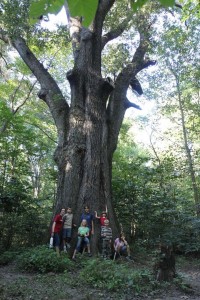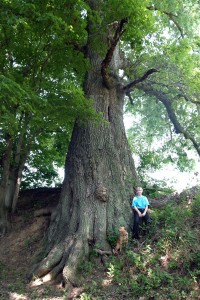Searching for Illinois’ Biggest Trees
By Chris Evans, University of Illinois Extension Forester
Even though Illinois is known as the Prairie State, historically about 1/3 of the state was forested, totaling nearly 14 million acres! The strong-hold was within the rolling terrain of the Shawnee Hills in deep southern Illinois and the dissected landscape along the big rivers. Illinois is home to over 180 species of trees and large shrubs, an amazing number, helping to make our forests some of the most diverse in the United States. Many of our forests are dominated by oaks and hickories (In fact, Illinois is home to 20 species of oak and 10 species of hickory), but Illinois also has beech cove forests, mixed pine forests, cypress/tupelo swamps, cottonwood and willow riparian forests, and other habitats. Our rich soils, often formed from wind-blown silt (called loess) and ample rainfall created conditions to grow some truly huge trees. Tales of settlers finding humongous sycamores, big enough to live in, reoccur in the history of westward expansion into Illinois.

Children check out the State Champion Cherrybark Oak tree located along the Heron Pond Trail at the Cache River State Natural Area in Johnson County. Photo courtesy Chris Evans
However, nearly all of Illinois’ forests were cut or cleared by the late 1800s as there was a huge demand for wood and fuel at that time. Steamboats, iron furnaces, sawmills, and homebuilding all required vast amounts of wood. Agriculture, homesteads, farms, westward settlement, and urban development dotted the landscape, replacing Illinois woodlands. This lead to a drastic decrease in both the amount of forests in Illinois and the age of our trees. By the early 20th century, we were left with under 3 million acres (about 8% of the land area), much of that young forest, recovering from the great cutovers of the previous decades.
After that drastic decrease, the forest has been slowly growing, both in size and extent. Landowners allowed sections to grow into trees to create farmland woodlots, other sources were favored over wood for energy and heat. Seedlings, sprouts, and small trees left from the cutovers grew back into forests. Programs, such as the Conservation Reserve Program (administered by USDA-Natural Resources Conservation Service) and the Forestry Development Act (administered by IDNR) encouraged and aided landowners to plant trees. The Arbor Day foundation promoted trees and forests to school children. Farmland, overworked and eroded, was bought by the state or federal government and planted into trees to create national forests, state parks and other public lands. Depression era programs, such as the Civilian Conservation Corps (CCC) and the Work Projects Administration (WPA), planted millions of trees in Illinois, both to heal the land from erosion and to create jobs for people in a time of need. By 2015, the forest cover of Illinois grew to nearly five million acres, about 14%, of Illinois. Still down from historic levels but a huge increase.

The National Champion Shumard Oak tree is located in Illinois' Union County. Photo courtesy Jay Hayek
To help raise awareness about Illinois forests and help celebrate the diversity and quality of our native tree species, the University of Illinois Extension Forestry manages the Illinois Big Tree Register. This is a list of the biggest specimens of each native tree species in Illinois. This program was actually started by the Illinois Department of Conservation in 1962, being transferred to the University in 2006. This is more than a contest to find the biggest trees. It promotes enthusiasm for trees, forests, nature, and conservation and encourages people to get out, travel, and enjoy the great outdoors!
It is easy to recognize a tree as being ‘big’ but how do we know if it is the ‘biggest’? Combining the measurements of tree height, diameter, and crown spread, a single score for each tree is calculated. The largest tree of each species is recognized as the state champion. State champions are recognized in our annual ‘Big Tree Register’ publication. They need to be re-measured at least once every ten years to remain on the Register. This monumental tasks is aided by volunteers. Illinois Extension Forestry is always on the lookout for folks interested in the outdoors and willing to seek out and find new big trees to nominate, relocate and measure old champions, and visit new nominations to verify species and score. In addition to being extremely useful and appreciated, these volunteers have a lot of fun and get to see some of Illinois’ largest living organisms!
Big trees can be found throughout Illinois–in forests, parks, and yards. A lot of the state champion trees are on public lands but more are on private lands. Landowners, owners of some huge trees, have recognized the uniqueness of what they have and nominated their trees for inclusion on the register.
Southern Illinois is home to a large number of these state champion trees, due in part to the vast amount of forests down here and in part to many native trees being found only in the southern portions of the state. The largest (i.e. highest scoring) tree in Illinois is the state champion bald cypress, found at the Cache River State Natural Area. While this tree is not particularly tall (64 feet) and actually has a relatively small canopy spread (37 feet) it is over 130 inches in diameter!
Illinois is lucky enough to claim four national champion trees. The biggest Ohio buckeye, Kansas hawthorn, Scarlet hawthorn, and Shumard oak known reside in Illinois.
As we continue to gather nominations for state champions and find new volunteers for the program, keep an eye out for big trees. They are out there, we just need more people searching for them!
CLIFFTOP, a local nonprofit organization, is focused on preserving and protecting area bluff lands.
A version of this article appeared in the March 16, 2018, edition of the Monroe County Independent.
© 2018 all content rights reserved Clifftop NFP
Comments are currently closed.
